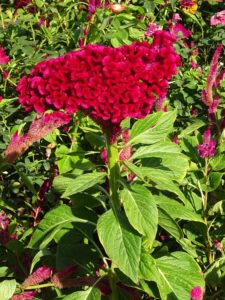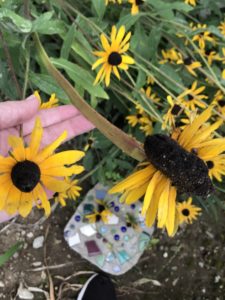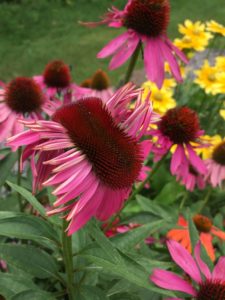Hello fellow readers. I enjoy being stumped by mysterious and sometimes magnificent garden dilemmas. Dorrie of Lebanon, CT, found my previous column about Deformed Flowers on Black-eyed Susan. The culprit— insects and a pathogen named Aster Yellows Disease (link below). But I had never seen artful, extended centers of Rudbeckia and Coneflower (Echinacea) such as those in the photos Dorrie sent. It turns out to be the fascinating anomaly of fasciation.
She writes, “a couple of stocks on one of my Black-eyed Susan plants are wide, and the blossoms have weird, elongated centers. I was showing my sister, and when she got home in Vermont, she found a few on her Coneflowers. It’s odd because the entire plant isn’t infected, just a stem of two. Do you have any idea the problem?”
Fasciation is not a problem at all.
After reaching out to two favored puzzle-solvers and digging deeper into the dilemma, it turns out it’s not a problem at all, but a beautiful anomaly called fasciation.
Lynn Waclawski of Warren County’s Rutgers Cooperative Extension writes, “I have never seen it before! It’s sure unique looking. If you do not see any symptoms of Aster disease, maybe it’s just some crazy mutation. Go ahead and get a lottery ticket now :^).”
I should note that if weedkillers or herbicides drift into your garden, it can cause deformities in the new growth of plants; one of the reasons I forgo them. But If there’s no evidence of chemical damage, it’s likely fasciation. At the risk of getting too scientific, not my forte, I’ll describe it like this:
Fasciation is an unintentional genetic modification.
The meristematic cells of plants develop into the various parts of a plant – stems, leaves, or flowers. With fasciation, the cells flatten, causing stems to broaden or flower centers to spread out looking as though it’s two-headed. It can also cause an overabundance of leaves and flower buds in areas of the plant.
The “mistake” is like an unintentional genetic modification—a defect in the DNA code. Or it could be caused by insect damage or viral infection. It’s most noticeable in stems— looking like flattened ribbon-like stems, twisted stems, or bushy growth. And blooms—often looking like two flowers fused much like conjoined tomatoes or squash.
What causes conjoined vegetables and fruit anyway?
Speaking of, a lifelong friend Dotty of Fishkill, NY, posted a Siamese twin yellow squash on Facebook. They appear to have grown together because they were too close to each other on the stem. But it’s a result of pollinators fertilizing two of the flowers’ ovaries instead of one. I’ve read it occurs about as often as sets of twins.

Cockscomb- Photo Attribution: Lumaca, CC BY-SA 4.0 via Wikimedia Commons
Some plants are cultivated to have Fasciation.
I like to think of these things as magical mutations, not a mistake. Fasciation is not contagious nor likely to come back again on the same plant.
However, plants are cultivated to have fasciated blossoms and stems, such as cockscomb, an annual here. Celosia argentea var. cristata (formerly Celosia cristata) is a fuzzy favorite with unusual scarlet combs that are crumpled and lobed. In the case of cockscomb, the fasciation passes along to the next generation in the seeds.
So, unless you see signs of disease, Dorrie, enjoy the artful, slightly freaky, and fun anomaly. Mother Nature can be so clever. Garden Dilemmas? AskMaryStone@gmail.com (and your favorite Podcast App.)
Related Column Deformed Flowers on Black-eyed Susan
And tune in to the Garden Dilemmas Podcast featuring this story.






I found this interesting, as my Black-eyed Susan’s are producing some wildly unique flowers. I dont see disease..so Im just enjoying what nature seems to have delivered
Would be happy to share photos if you wouod like..
Hi Nancy, I’d love to see your “wildly unique flowers.” Feel free to email me at AskMaryStone@gmail.com. Mother Nature is such an artist! Thanks for reading my column post, Mary
Found your article while searching flattened echinacea stems. Thanks for the totally useful and fascinating (ha) info!
I’ll send you a pic of mine 🙂
Great! Thank you Janice. Its a fascinating anomaly indeed!
My Strawflower blooms had some of this if you would like another photo for your article.
Sure, please send it to AskMaryStone@gmail.com. Thank you Emmy!